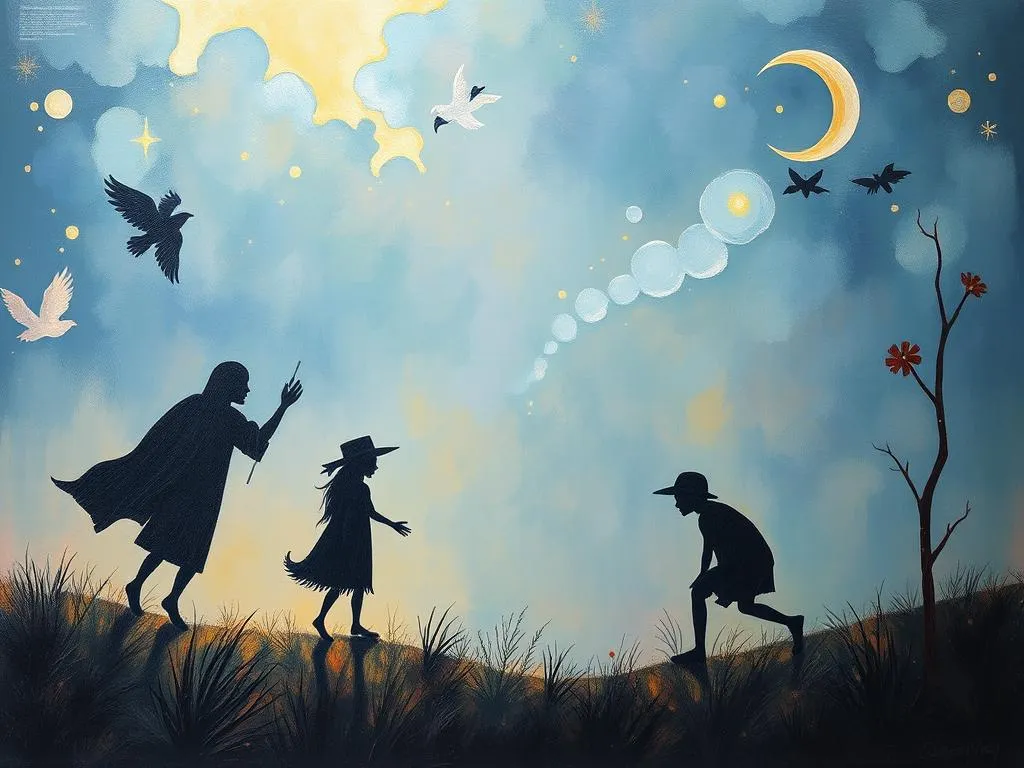
Dreams have fascinated humanity for centuries, serving as portals to our subconscious and offering glimpses into our deepest fears, desires, and unresolved conflicts. Among the myriad of dream symbols, shadow figures stand out as particularly intriguing and often unsettling. These dark, elusive entities can evoke a range of emotions, from fear to curiosity, prompting many to seek understanding about their significance. This article delves into the symbolism and meaning of shadow figures in dreams, explores various scenarios and their interpretations, and provides insights on connecting these dreams to real-life experiences.
Symbolism and Meaning
When interpreting dreams featuring shadow figures, it’s essential to understand the underlying symbolism. Shadow figures are often regarded as manifestations of the unconscious mind. They may represent aspects of ourselves that we have repressed or denied, such as fear, guilt, or shame. In psychology, this aligns with the concept of the shadow self, a term coined by Carl Jung, which describes the parts of our personality that we may not want to acknowledge.
The color black is significant in this symbolic landscape. It often embodies the unknown, mystery, and even the potential for transformation. The presence of shadow figures can indicate that there are unresolved issues or emotions lurking in the depths of our psyche. These figures might also symbolize fear of the unknown or the aspects of life that feel out of our control.
Interestingly, shadow figures can also represent external influences. They may embody feelings of being watched, judged, or even threatened by others in our waking lives. This duality of interpretation—representing both internal struggles and external pressures—makes shadow figures particularly complex and compelling.
Additionally, the context in which the shadow figures appear can significantly alter their interpretation. For instance, if a shadow figure is pursuing the dreamer, it may signify a desire to confront one’s fears or evasion of responsibility. Conversely, if the figure is passive or merely present, it may suggest that the dreamer is beginning to acknowledge and integrate these shadow aspects into their conscious awareness.
Key Scenarios and Variations
The nature of shadow figures can vary dramatically based on the scenarios experienced in the dream. Each variation offers a unique lens through which to interpret the dream’s meaning.
In one common scenario, a dreamer may find themselves being chased by a shadow figure. This scenario is often associated with a strong sense of anxiety or fear. The dreamer may be avoiding confronting certain truths about themselves or their life situations. This chase symbolizes the importance of facing one’s fears rather than running away, suggesting that resolution lies in acknowledging what has been suppressed.
Alternatively, encountering a shadow figure that stands still may evoke feelings of curiosity rather than fear. This static presence can indicate that the dreamer is beginning to confront and accept the darker aspects of their personality. The shadow figure here serves as a guide, encouraging self-reflection and personal growth.
Another variation occurs when the dreamer interacts with the shadow figure. This scenario can lead to profound personal insights. For example, if the dreamer speaks to the figure or attempts to understand its intentions, it may symbolize a willingness to explore hidden parts of themselves. This interaction can be empowering, suggesting that the dreamer is on a path toward self-discovery and healing.
Moreover, the setting of the dream plays a crucial role in interpretation. For instance, if the shadow figures appear in a familiar location, it might indicate that the issues at hand are rooted in the dreamer’s past experiences or relationships. On the other hand, if the setting is unfamiliar, it could suggest that the dreamer is facing new challenges or changes that are causing feelings of uncertainty.
In some dreams, shadow figures may appear alongside other symbols, such as doors or mirrors. These symbols can provide additional context. A shadow figure emerging from a door might signify new opportunities that are overshadowed by fear, while a figure appearing in a mirror could reflect inner turmoil concerning self-image or identity.
Real-Life Connections and Takeaways
Connecting dreams of shadow figures to real-life experiences can be a powerful tool for self-reflection and personal growth. Dreams often serve as mirrors, reflecting our waking lives and the emotions we may be struggling to process. When encountering shadow figures, it’s essential to ask oneself, “What aspects of my life am I avoiding or denying?”
This introspective question can lead to valuable insights. For example, if one frequently dreams of shadow figures during stressful periods, it may indicate that unresolved issues at work or in personal relationships are manifesting in their dreams. Acknowledging these feelings can pave the way for constructive conversations and resolutions.
Practical advice for self-reflection includes keeping a dream journal. Recording dreams immediately upon waking can help capture the details and emotions associated with shadow figures. Over time, patterns may emerge, revealing recurring themes or unresolved conflicts. Reflecting on these patterns can lead to a deeper understanding of the self and areas that require attention.
Meditation and mindfulness practices can also facilitate a connection between dreams and waking life. By cultivating self-awareness, individuals can better recognize the emotions and thoughts that surface during dreams. Engaging with these feelings in a non-judgmental manner can foster healing and acceptance of one’s shadow aspects.
In addition to personal reflection, discussing dreams with trusted friends or therapists can provide new perspectives. Conversations about shadow figures can uncover shared experiences and insights, helping to normalize the feelings of fear or anxiety associated with these dreams. This communal aspect of understanding can be incredibly validating, reminding individuals that they are not alone in their struggles.
Ultimately, embracing the presence of shadow figures in dreams can lead to profound personal transformation. Rather than viewing these figures solely as sources of fear, individuals can learn to see them as opportunities for growth and self-discovery. By confronting the shadows, one can illuminate the path toward a more integrated and fulfilling life.
Conclusion
In conclusion, shadow figures in dreams are rich with symbolism and meaning. They serve as portals to understanding our fears, insecurities, and the parts of ourselves that we may have hidden away. By examining the various scenarios in which these figures appear, we can gain valuable insights into our waking lives and the unresolved emotions that need attention.
Encouraging self-reflection and open discussions about these dreams can help individuals navigate their inner worlds with compassion and courage. As we continue to explore the mystery of shadow figures, we unlock the potential for personal growth and transformation. So, the next time you encounter a shadowy presence in your dreams, take a moment to pause, reflect, and welcome the opportunity for deeper understanding.







